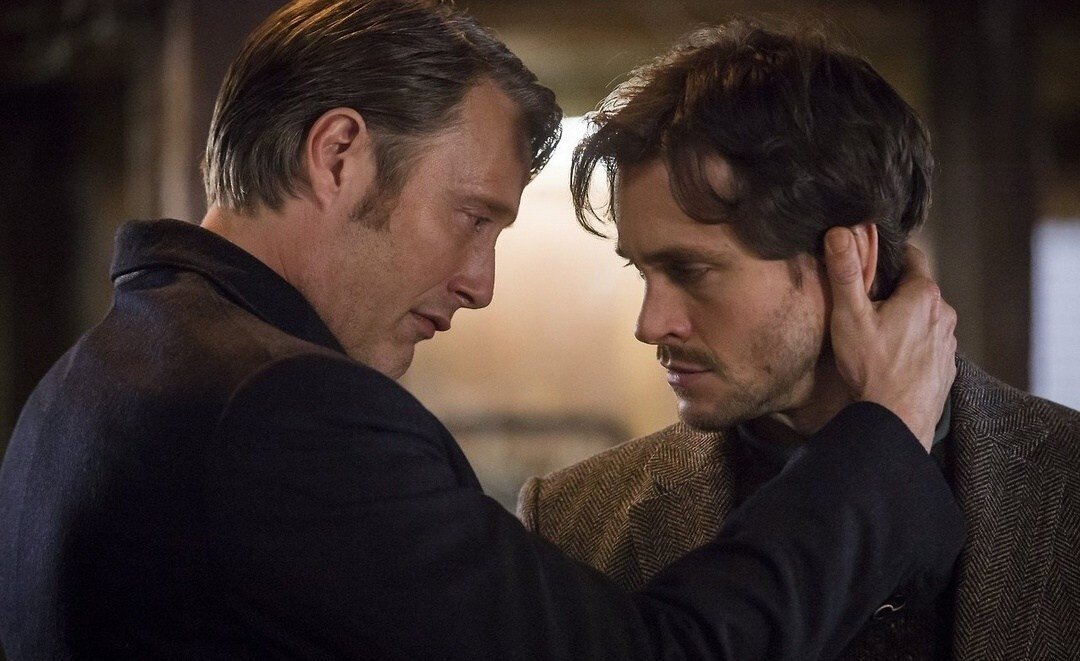Locating the Monstrous in Bryan Fuller’s Hannibal
In “The Number of the beast is 666” (3.12), Will Graham (Hugh Dancy) asks Dr. Bedelia DuMaurier (Gillian Anderson), “Is Hannibal in love with me?” This moment makes explicit the slow burn of the building romance between Will and Hannibal Lecter (Mads Mikkelson) that began in season one as a kind of peculiar kinship, progressed in season two to an elaborate cat-and-mouse game, and culminates in season three with the consummation not of their sexual tension but of their shared murderous tension. Will and Hannibal share an incredibly complex bond—psychiatrist and patient, manipulator and manipulated, hunter and prey, dark doubles—but it is always underscored by a deep mutual respect and significant reciprocal intellectual bond.
Hannibal alone understands Will but, unlike the rest of the psychiatric community, doesn’t seek to dismantle his psyche for scientific profit—thus Hannibal becomes Will’s mental port against the storm of his own mind. Conversely, Will’s ability to empathize with anyone—including murderers—offers Hannibal a unique chance to be seen, known, and Lecter can’t resist the temptation. Although they find themselves alternately working together or duplicitously working at cross purposes, there is always an element of flirtation that charges their discourse, no matter how oblique their conversations become.
Harry M. Benshoff, in his landmark 1995 Monsters in the Closet: Homosexuality in the Horror Film (excerpted in The Dread of Difference) considers how horror has repeatedly aligned monstrousness with homosexuality, thus depicting it as an abnormal condition that must be eradicated within the narrative in order to restore the heteronormative patriarchy, and he tracks how the particulars of that association have changed in order to most efficiently reflect the particular anxieties surrounding homosexual threat at given cultural moments. Benshoff also looks at the effect of a broader understanding of queerness (not merely homosexual), suggesting it resists “binary definitions and proscriptions of patriarchal heterosexism” (119). Queerness, he states, “seeks to go beyond these and all such categories based on the concepts of normative heterosexuality and traditional gender roles to encompass a more inclusive, amorphous, and ambiguous contra-heterosexuality” (119). The queer viewer, then, becomes adept at recognizing the ways monsters are coded as queer because, as he argues in the beginning of the piece, at least as viewed by normative society, “homosexuality is a monstrous condition” so queer representation in horror is then located within the monstrous (or, in the case of the rare explicit queer character, punished and swiftly eliminated from the narrative) (116, 127-9). The monstrous represents the Other, and queerness is invariably the Other.
“Bee Guy”
However, this begs the question: is this still true? Contemporary horror television is often—not always, granted, but often—populated with queer characters who are positioned not as the monster, but as the protagonist. That which is monstrous is often representative of “normative” cultural ideologies: heteropatriarchy, fascist government, despotic leaders, an oppressive State apparatus, or neoliberal late-stage capitalism. This gives rise to the question of, in Bryan Fuller’s version of Hannibal, is Hannibal Lecter the monster? He certainly commits monstrous acts—cannibalism is one of culture’s few true taboos—but the world of Hannibal is one of moral grey areas that is deeply invested in how spectrums (of sexuality, of beauty, and of monstrousness) are both constructed while simultaneously constructing us. Lecter’s murders, which transcend to the realm of high art, are held in stark contrast against the more base murders of the people he and Will investigate—despite an aesthetic flair, most of the killers are motivated by their passions for revenge, punishment, or infamy. Lecter, by contrast, kills—and eats—the rude, and by doing so is in a way involved in the maintenance of polite society that the other killers transgress. In addition, dispassionately killing for food—and consuming that which is beneath you, like a sophisticated Renfield—feels, as we watch, somehow more rational than, for instance, a social worker who slaughters women because of his misogyny or an acupuncturist who lobotomizes and makes a beehive of people who complain too much. Consider Hannibal against the character of Mason Verger (Michael Pitt/ Joe Anderson), a universally-detested figure in t he narrative who is both a sadist and a pedophile in addition to being the heir of an immensely successful capitalist empire that allows him to maintain his position. Hannibal may be… complicated, but Mason is undoubtedly the monster.
It’s important that this is a deeply queer text, and that while Will and Lecter both transgress the law and Judeo-Christian ethics, they nonetheless are doubly figured as protagonists. They are located at the center of the narrative, and we are afforded Lecter’s interiority in the same way we are Will’s. This both refuses to code queerness as inherently monstrous—don’t discount Alana Bloom’s (Caroline Dhaverna) sexual fluidity and her relationship with Margot Verger (Katharine Isabel), which may have elements of transactionality but otherwise appears fairly healthy—as well as confronting the audience with how we rationalize and accept violence when we develop an affinity with protagonists such as Will and Hannibal, who, throughout the narrative, we are inevitably in the position of rooting for.
Works Cited
Benshoff, Harry M. “The Monster and the Homosexual.” The Dread of Difference, edited by Barry Keith Grant, second edition, U of Texas P, 2015, pp. 116-43.
Fuller, Bryan, creator. Hannibal. Gaumont Productions, 2015-17.

